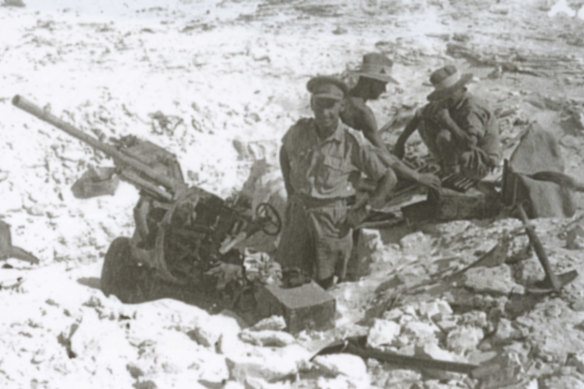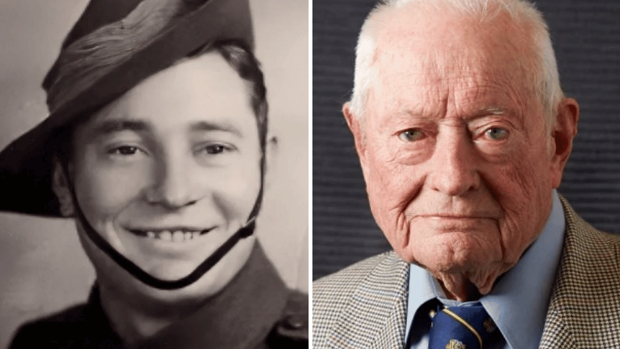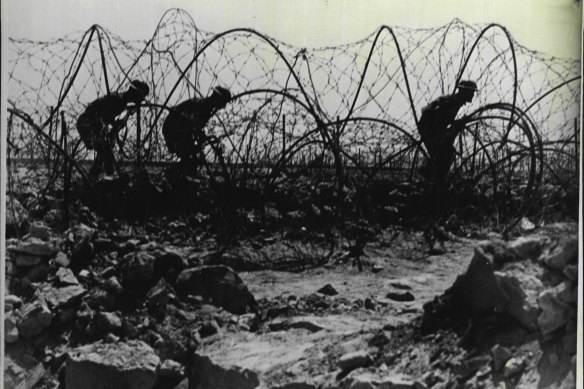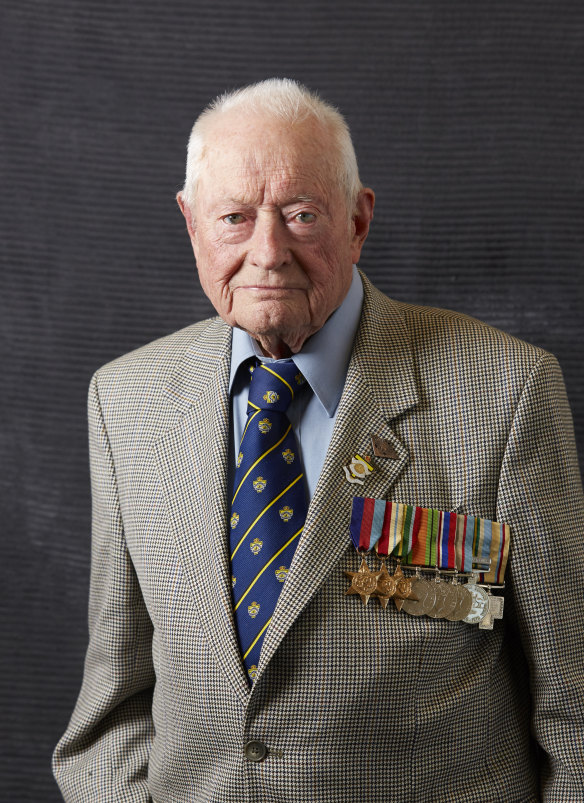This was published 3 months ago
Opinion
‘I don’t want to be a martyr’: Last Rat of Tobruk dies, aged 102
Peter FitzSimons
Columnist and authorLord Haw-Haw, the infamous British traitor who broadcast from Berlin during World War II, got it wrong by 83 years. When Australian forces first took Tobruk in 1941 and held it against the might of General Erwin Rommel’s Afrika Korps, the propagandist was quick to predict that “the sons of sheep herders”, these “self-supporting prisoners of war”, caught like “rats in a trap” would be all wiped out.
“These rats of Tobruk,” he infamously sneered. “Living like rats, they’ll die like rats.”

A gun pit in Tobruk, North Africa.
Actually, no.
For in fact, the Australians, who were the predominant defensive force in the key Libyan port, were able to hold it through 1941, against four major attacks by the Afrika Korps and the Italian Army.
Lord Haw-Haw was humiliated, and the tag he gave the defenders, the “Rats of Tobruk”, became a cherished badge of honour between a brotherhood of men who would look after each other after the war in much the same manner as they had during the siege.
Now, finally, last Sunday, the very last man left standing of those 14,000 Rats has died, just shy of his 103rd birthday.

Tom Pritchard, the last living Rat of Tobruk.
It was just before Anzac Day last year that Tom Pritchard, a former ambulance driver with the 2nd/5th Field Ambulance during eight months of the siege, became the last of the mighty generation left to hold the torch.
Though he declined a formal interview with The Sydney Morning Herald and The Age, he did pass a message on to this writer via an intermediary: “I do not want to be made a martyr. Tell him to look up some of the blokes who died, and write about them.”
That response, forget me, look after the others, was emblematic of the entire selfless approach taken by the Rats, and was the key to their extraordinary achievements.
It was the great ABC correspondent Chester Wilmot who best captured this spirit when he wrote these words from that windswept dusty hell on the southern shores of the Mediterranean.
“The spirit which has made Australia is the spirit which has held Tobruk,” he typed. “The inspiring and binding force in Australian life isn’t tradition or nationalism or social revolution. It’s quite a simple thing. Henry Lawson called it MATESHIP . . . the spirit which makes men stick together. In Australia, by sticking together, men have defied drought, bushfire and flood. In Tobruk they’ve scorned hardship, danger and death, because no Digger would ever let his cobbers down. In Tobruk, for the first time in this war, the Germans were thrust back by a spirit that even tanks and dive-bombers could not conquer.”
Tom Pritchard VX23441, a young man with a larrikin spirit from Portland, Victoria, whose father fought in the famous battle of Hill 60 in the First World War, was no bit-player in the siege, but right in the thick of the action.
When Italy joined the war on the side of the Germans in June 1940, Mussolini’s forces in North Africa threatened the Suez Canal. To stop them, Australian forces were dispatched to secure the key Italian-held port of Tobruk to deny the Axis forces an obvious supply point in any mass eastern sweep to Egypt.
The Australians of the Sixth Division captured Tobruk in late January 1941, with the signal to attack coming from a lieutenant of the 2/1st Pioneers: “Go, you bastards!”

The Easter 1941 battle for Tobruk was a bitter encounter in which the headlong advance of German General Erwin Rommel’s Afrika Korps came to an abrupt halt. Credit: Fairfax Media
And go those bastards did, overwhelming Italian positions after bitter fighting. A day later, the cable came from Cairo asking how many Italian prisoners there were, and the answer from the Australians made it into the official report given to British Prime Minister Winston Churchill: “20 acres of officers and 100 acres of other ranks!”
A desperate Adolf Hitler sent Rommel and his Afrika Korps to take it back. It was for Australia’s General Sir Leslie Morshead, commander of the fortress, to organise his initial forces, consisting of Australian infantry on the perimeter and British artillery on the inside, to withstand Rommel’s devastating Panzer tanks, infantry, artillery and Stuka bombers, a combination which had already devastated Europe.
Morshead’s key insistence was the Diggers dig in, to effectively live underground to be able to withstand the bullets, bombs and shelling, and only come out to repel attacks.
But though they lived like rats, they fought like lions.
The first battle royale took place in the early hours of April 14, 1941, as the Afrika Korps launched en masse, tanks rumbling forward, with infantry behind, attacking positions already shelled by artillery.
There were many casualties, and Pritchard was one of the stretcher bearers of the 2/5th Field Ambulance going out under heavy fire to rush his fellow Diggers to aid stations.
Bathed in blood, under fire, the stretcher bearers did their work, and when the smoke had cleared, the Afrika Korps had not only retreated, but no fewer than 16 of Rommel’s tanks had been destroyed, the first time in World War II the German army had been stopped.
The Australians and their allies continued to hold back the Germans, with Pritchard among those going out under fire to rescue and provide succour to the wounded. When the Germans continued to redouble their efforts, General Morshead switched to more aggressive tactics.
When one of the British officers arriving with reinforcements brought with him a London newspaper bearing an article with the headline, “TOBRUK CAN TAKE IT!” Morshead’s response was immediate.
“We’re not here to take it,” he thundered to his officers, “we’re here to give it!”
As Morshead put it in a subsequent conversation with Chester Wilmot: “I determined that no-man’s-land would be our land.”
Aggressive raids were launched, destablising the attacking forces, and the only cables Hitler got from Rommel through 1941 relayed bad news.
By the time the last of the Australians were pulled out in December, 15,000 men were proud to call themselves a “Rat of Tobruk”, and the mateship endured for the next 80 years and more.
Pritchard, who also served in the New Guinea battle of Shaggy Ridge, eventually settled in Victoria with his new bride Gwen.

Tom Pritchard, the last living Rat of Tobruk.Credit: Liza-Jayne Lyons/Australian War Memorial
He worked with Victoria’s State Electricity Commission and together they raised four children, living in Dandenong. The secretary of the Rats of Tobruk Association, Lachlan Gaylard, described Pritchard last year as “a low-key larrikin”, a man whose spirit remained intact, even as the flesh grew weak and the joints began to creak.
Pritchard was a member of the Rats Committee for many years and frequently caught up with fellow Rats at Tobruk House, in Melbourne’s Albert Park. As a breed, they remained notable for the strength of the bond between them, their willingness to help each other and each other’s families out. And those families returned the love in kind, proud of these men and how they still stuck together.
By late 2022, there were just half-a-dozen Rats left, but by Anzac Day last year, Pritchard was the last one. He lived the rest of his days quietly, facing his various medical challenges with the very stoicism that was the mark of his fine generation.
Bravo, you Rats. You did the nation proud.
And bravo and vale, Tom Pritchard VX23441. You were the last one left to hold their torch aloft, and were a worthy torch-bearer for their selfless, stoic way.
Lest we forget.
Peter FitzSimons published Tobruk in 2008.
Start the day with a summary of the day’s most important and interesting stories, analysis and insights. Sign up for our Morning Edition newsletter.